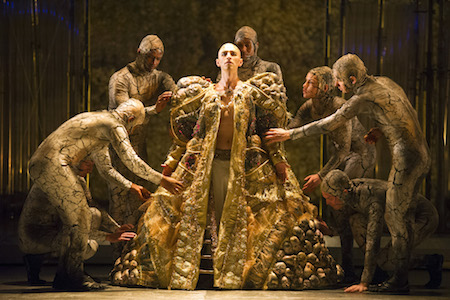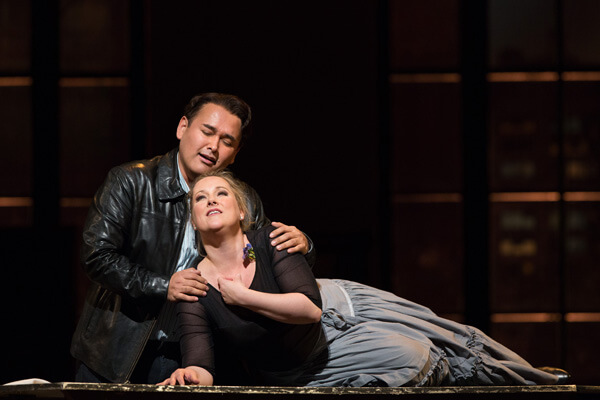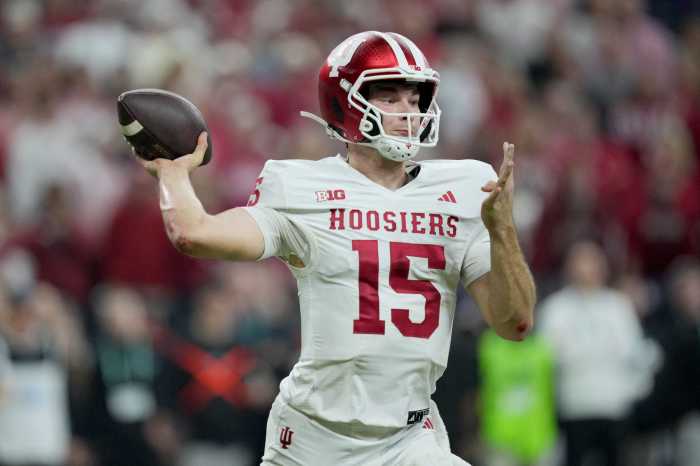Elza van den Heever and Stuart Skelton in the San Francisco Symphony semi-staged production of Britten’s “Peter Grimes.” | STEFAN COHEN
BY DAVID SHENGOLD | San Francisco Opera presented three works during its summer season, smartly timed to overlap with Pride Day and Frameline’s Film Festival. Volunteering duties at the Castro kept me from seeing Patricia Racette in the beautiful Jun Kaneko’s beautiful “Madama Butterfly” production. But Racette — who sang both Margherita and Elena in “Mefistofele,” plus the title role of “Dolores Claiborne” this season at the company where she rose to prominence — also ventured a new role, Julie in “Show Boat.”
The programming — surpassingly mainstream for a company that used to roll out “Wozzeck, “Katerina Ismailova,” “Lear,” and “Orlando” — also included the final (one hopes) revival of John Copley’s stuffy, unimaginative “La traviata” staging, which has served the company in “Classic Comics” fashion for many years. Laurie Feldman had tweaked it soundly without reanimating it. The sole arresting image was the well-lit (by Gary Marder) tableau opening Act III, in Violetta’s sickroom.
Vladimir Stoyanov showed a solid, well-produced baritone of reasonably high quality. His Germont was evenly vocalized but faceless, all stock gestures and insufficiently alert text, in need of an animating director. One wants to like Albanian tenor Saimir Pirgu, who looks reasonably like a latinate leading man and has clear talent, but like his 2011 Tebaldo here, his Alfredo sounded dry, brusque, and charmless except in a few moments where he introduced some head voice into the mix. Flatness intruded at first; he drove after a more spintoish sound so much that loud, high passages were the only places the timbre really hung together. Serious restudying would benefit Pirgu; perhaps more technical security would free him to react more to his scene partners.
Verdi, Britten, Kern were on the program in San Francisco
Music director Nicola Luisotti — on some occasions quite galvanic — here provided idiomatic but sometimes rather slack support; “Parigi, o cara” expired due to an ineffective tempo. He did nurture Nicole Cabell, in the role of Violetta, with considerate allowance of rubato.
The evening’s saving grace (besides Verdi’s music) was Cabell. Opening Night buzz was mixed, but by this fifth performance (June 25) she was admirable and likable. An attractive stage figure with graceful plastique, Cabell is blessed with a lovely and — rarer these days — individual sound. She’s essentially a billowing lyric soprano with good agility, extending to fine staccati in Act One’s rigorous demands. High C sharp — key here — holds no terrors for Cabell. One of the admirable things about her singing — setting her off from much of the competition these days — is her command of varied dynamics and varied tone color.
At first, rapid music passed with unincisive diction — and in this iconic part, every utterance needs verdian “parola scenic,” the expressive utterance a Muzio, Callas, Sills, or Scotto brought to it. Greater experience may bring that. Already, in more conversational sections, Cabell used the text with care and point.
For me, “Show Boat” (July 1) is the only great American operetta. Its relative seriousness, courtesy of Oscar Hammerstein’s question-raising libretto, obviously had an eventual effect on musical comedy as a genre. Plus, Jerome Kern’s tuneful music is often very effective.
John DeMain used a reasonable edition, leading the orchestra well; they provided some sheen but didn’t always unbend when needed. Francesca Zambello’s well-traveled fiesta of a staging avoided almost any depth, since the cast was largely directed to deliver dialogue as brassy shtick and the visual emphasis was on cute l’il kids, balloons, and razzle-dazzle dancin’.
Holdovers from Chicago in 2012, Angela Renée Simpson (a hilarious Queenie) and Morris Robinson (an elemental-voiced Joe) practically walked off with the show, though two of the other opera singers offered fine work. Michael Todd Simpson looked and sounded exactly right as Ravenal, capturing the tricky idiom and — mercifully — not forcing his natural charm on the audience.
Racette danced and moved well as Julie, but laid the accent on a bit unrelentingly. Her two numbers were done with a real command of pop style and registration, but Zambello staged “Can’t Help Lovin’ that Man” without foreboding or pathos, and though one admired Racette’s accomplishment on “Bill,” which succeeded on the level of a cabaret offering, no hearts were broken.
Heidi Stober’s Nola, with too light a voice, lacked genuine star presence. Harriet Harris (Parthy) had some funny moments, but Bill Irwin, often a great actor, channeled Ray Bolger here and was just too self-indulgent. The audience clearly loved hearing this delightful score but clumsy amplification spoiled much of the dialogue where I sat.
Next summer promises more variety, with “Les troyens” as well as a world premiere joining “Le nozze di Figaro.”
Michael Tilson Thomas and the San Francisco Symphony offered gay-specific programming, with concert readings of Britten’s “Peter Grimes,” highly effectively semi-staged and clothed by James Darrah. Adam Larsen’s fine black-and-white videos proved key in conveying the work’s sea-haunted atmosphere.
On June 29, a very substantial Pride Day matinée crowd deservedly cheered the strong, moving work of Stuart Skelton (Peter) and Elza van den Heever (Ellen). The South African soprano, locally trained, showed a freedom and tonal beauty that eluded her in the Met’s “Stuarda.” Ellen’s contribution to Act II demands dramatic scope; van den Heever follows Christine Goerke and Christine Brewer in actually offering the goods, and her acting proved very affecting. Skelton has patterned some touches on Jon Vickers and Anthony Dean Griffey — what better models? — and offered a powerful, beautifully sung and acted anti-hero, l ovely in head voice and at full Heldentenor tilt, lacking perhaps only enough middle dynamic.
Nearing 70, Alan Opie (Balstrode) remains oak-solid vocally; his performance was full of subtle verbal and visual touches. Nancy Maultsby made a satisfying Mrs. Sedley, while Ann Murray — though she knows the idiom and her craft — remains a very mature top-free soprano rather than the contralto implicit in Auntie’s music. Eugene Brancoveanu made Ned’s words admirably clear but the timbre emerged too rough and Alberich-like. Veteran Kevin Langan (Hobson) continues to maintain a high professional standard. As Swallow, John Relyea sounded firmer and richer than for some time, though vowels were over-darkened. Precise in pitch and articulation, Kim Begley (Horace Adams) made for luxury casting.
Tilson Thomas predictably went to town on the score’s showier bits. Some more contemplative stretches required more soul, but the string playing — in particular — was excellent. Ragnar Bohlin’s chorus excelled in this very memorable show.
David Shengold (shengold@yahoo.com) writes about opera for many venues.





































